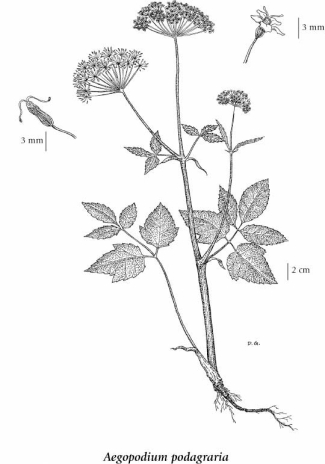Aegopodium podagraria L.
goutweed (bishop's weed; ground elder)
Apiaceae
Introduction to Vascular Plants
goutweed (bishop's weed; ground elder)
Apiaceae
Introduction to Vascular Plants
Photograph
© Gary Ansell (Photo ID #25187)
Introduction
Goutweed, or bishop's weed, is an introduced rhizomatous species in the Carrot Family (Apiacea) that originates in Eurasia but is commonly planted in gardens in North America. It has escaped in several regions, and is now reported as naturalized from several eastern US states, four western states and six Canadian provinces (USDA 2011). It is considered an invasive species in urban areas. In British Columbia, it is found several sites in the southern part of the province, where it can form infestations. Infestations are noticeable in ravines near urban gardens in the Vancouver area, and there are recent reports of infestations in campsites along the Chilliwack river, and at Blackie Spit.
In the garden, bishop's weed spreads prolifically by rhizomes in both sun and shade, and is difficult to eradicate. The white umbels of flowers appear in June and July in our region.
|
Species Information
General:
Perennial herb from a long-creeping rhizome, often in bundles; plants creeping, patch-forming; stems hollow, grooved, glabrous, 0.3-1.0 m tall.
Leaves:
Basal leaves 2 times pinnately-cut, leaf segments stalked, egg-shaped, the tips long-pointed, stem leaves deeply indented with leaflets once to several times compound, 10-20 cm long, the segments 4-8 cm long, sessile or shortly stalked, reduced upwards.
Flowers:
Inflorescence terminal in compound umbels; petals white or sometimes pink, usually lacking bracts.
Fruits:
Egg-shaped, 3-4 mm long, ribs inconspicuous.
Notes:
This is potentially a very persistent weed, especially in calcareous habitats.
Illustration

If more than one illustration is available for a species (e.g., separate illustrations were provided for two subspecies) then links to the separate images will be provided below. Note that individual subspecies or varietal illustrations are not always available.
Illustration Source: The Illustrated Flora of British Columbia
Habitat and Range
Mesic to dry roadsides and waste places in the lowland zone; rare in SW BC, known only from the lower Fraser Valley; introduced from Eurasia.Status Information
Synonyms
Synonyms and Alternate Names:
Aegopodium podagraria var. variegatum L.H. Bailey
Taxonomic Notes
This species spreads easily from root fragments and can spread into new areas as a result of the dumping of garden debris. It forms dense patches, displaces native species, and greatly reduces species diversity in the ground layer.
|